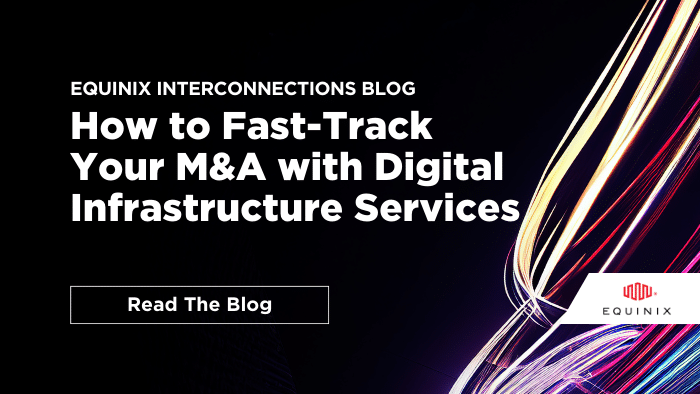[ad_1]
Fast-tracking time to market for M&As
In a recent survey by CIO Journal, top CIOs and IT leaders identified speed and agility as top 2023 priorities.[2] And indeed—speed and agility are especially critical during mergers, acquisitions and divestitures. Besides the requirement to adhere to the deadline to complete the deal, you need to get the new version of your business running smoothly as quickly as you can. And the inevitable internal changes required when two companies merge or separate means that your workforce needs to stay flexible and adapt quickly.
Speed and agility are also critical for your infrastructure itself. During a merger or acquisition, you’ll be bringing together different technologies, software, networks and more. You might be merging infrastructure across many global locations. Acquiring and deploying new physical hardware to merge or separate infrastructure can be time-consuming and involve high CAPEX and personnel expenses. And supply chain constraints can further slow the acquisition of physical equipment. Digital infrastructure, on the other hand, allows you to rapidly deploy infrastructure for hosting data and integrating networking services, thus accelerating deal closure and time to value.
Ensuring global reach and access to a rich partner ecosystem
No organization today does business alone. Partnerships and industry collaborations are essential to the way we work. In fact, at Equinix we’d even argue that your ecosystem is your infrastructure. Successful M&As necessitate access to all the right cloud and network service providers, in all the locations where your organization operates. Tapping into key partner services quickly, easily and securely can help your company accelerate M&A events. And being part of well-connected ecosystems will also future proof your business.
Often, when two companies merge, you have to decide what tools and services the merged organization will use. But at the start of the merger, different or incompatible tooling could still be mission-critical for one or both companies. Being in a vendor-neutral playing field like Platform Equinix®—with access to all the leading clouds, network providers and other industry-leading services—helps during that middle phase, when you’re still deciding what tools and services the merged company will use.
Finding a middle ground for data with a cloud-adjacent data strategy
In a world where most companies operate hybrid multicloud architectures, connecting data in on-premises infrastructure or colocation facilities with public cloud data is essential. That’s why cloud adjacency has become such an important part of the conversation. M&As require you to bring together a potentially enormous volume of data from two different companies, and it takes time to choose the proper route and placement of that data. If one company has a major public cloud footprint, planning for cloud-adjacency makes a lot of sense. In data centers like Equinix IBX® sites, you can position infrastructure adjacent to public cloud or repatriate public cloud data to a different cloud or on-premises location. Plus, you can bring data closer to your end users, customers and the acquiring company’s physical locations. In the case of M&As, this strategy could provide you with a middle ground for storing data while you figure out its ultimate destination. And it offers benefits like low latency and reduced data transfer costs.
How to accelerate your M&A closure with digital infrastructure services
Providing infrastructure solutions to connect two organizations is no easy task. But virtual infrastructure solutions can significantly simplify and accelerate a merger, acquisition or divestiture. Some of the reasons for this are obvious: digital infrastructure allows you to deploy solutions quickly, using an OPEX cost model, and you can scale up and down as needed before or after the merger.
For example, virtual networking services like SD-WAN gateways, multicloud routers and distributed edge firewalls via Network Edge enable businesses to quickly deploy and scale networks as their business evolves, while minimizing security risk. Virtual networking gives you far more flexibility to adapt as the merger progresses. And it reduces expensive, time-consuming manual labor.
Automated bare metal gives you an easy way to host compute and storage while the merger is in progress and you’re deciding where to put your data, between on-premises data centers and public cloud providers. And all these digital services can be powered by software-defined interconnection, so you can quickly and securely connect locations, clouds and other services.
Partner with Equinix to facilitate your merger, acquisition or divestiture
Equinix has facilitated many mergers, acquisitions and divestitures. Our digital infrastructure solutions make things easier for you as you undertake the technical challenge of consolidating the IT infrastructure of two companies. And we relish the opportunity to make this process faster and easier for our customers.
Here are some of the additional benefits of working with Equinix during your M&A or divestiture:
- Connection to industry-leading vendors: Platform Equinix gives you access to a rich ecosystem of 2,100 network services and 3,000+ cloud and IT services. Whoever you or the acquired company already work with, they’re probably at Equinix.
- Digital services: In addition to Network Edge virtual networking solutions, Equinix Fabric® provides flexible, secure virtual interconnection to your key partners and providers. And Equinix Metal® delivers automated, on-demand bare metal to help you scale your infrastructure quickly.
- Global reach: Equinix is a global platform with a presence in 71 markets in 32 countries. So, if your merger involves expanding to new markets, we can help you get there quickly.
Learn more about how Equinix can help your M&A or divestiture close with speed and agility while positioning your business for growth by downloading the Hybrid infrastructure for a digital age e-book.
[1] PwC, Global M&A Industry Trends: 2023 Outlook.
[2] Bella Lin, CIO 2023 Priorities: Speed and Agility, CIO Journal, The Wall Street Journal, December 30, 2022.
[ad_2]
